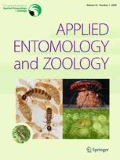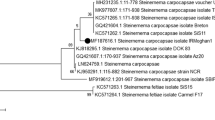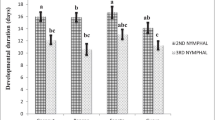Abstract
Mermithid nematodes (Mermithida: Mermithidae) infect and kill many different invertebrates and have been investigated for their potential as a biological control agent of insect pests. In this study, we conducted a survey of mermithid nematodes infecting fruit-piercing stink bugs (Hemiptera: Pentatomidae) in Japan. We collected fruit-piercing stink bugs in four different prefectures (Shizuoka, Mie, Tokushima, and Saga) and investigated the distribution and infection ratio by mermithid nematodes. The results indicate that the nematode infection ratio of Glaucias subpunctatus (Walker) was higher than that of Plautia stali Scott or Halyomorpha halys (Stål). Furthermore, significant differences in mermithid infection percentages were observed among regions and seasons, with the highest being in G. subpunctatus in Mie during May–June. Of note, all mermithid nematodes were isolated from stink bugs collected from plants, and no nematodes were isolated from stink bugs attracted to store lights. This implies that parasitism of mermithid nematodes may affect the behavior of the host stink bugs. Furthermore, we obtained DNA sequences and simple morphological characteristics for the nematodes isolated. This study indicates that the mermithid nematodes obtained from stink bugs belong in the genus Hexamermis.



Similar content being viewed by others
References
Adachi I, Uchino K, Mochizuki F (2007) Development of a pyramidal trap for monitoring fruit-piercing stink bugs baited with Plautia crossota stali (Hemiptera: Pentatomidae) aggregation pheromone. Appl Entomol Zool 42:425–431. https://doi.org/10.1303/aez.2007.425
Bergmann EJ, Venugopal PD, Martinson HM, Raupp MJ, Shrewsbury PM (2016) Host plant use by the invasive Halyomorpha halys (Stål) on woody ornamental trees and shrubs. PLoS ONE 11(2):e0149975. https://doi.org/10.1371/journal.pone.0149975
De Ley P, Blaxter M (2002) Systematic position and phylogeny. In: Lee D (ed) The biology of nematodes. Taylor and Francis, London, pp 1–30
Devasahayam S, Koya KMA (1994) Seasonal incidence of Hexamermis sp. (Dor., Mermithidae) parasitising larvae of top shoot borer Cydia hemidoxa Meyr. (Lep., Tortricidae) on black pepper. J Appl Entomol 117:31–34
Funayama K (1996) Sucking injury on apple fruit by the adult of brown marmorated stink bug Halyomorpha mista (Uhler). Annu Rep Plant Prot N Jpn 47:140–142. https://doi.org/10.11455/kitanihon1966.1996.140(in Japanese with English summary)
Fuxa JE, Fuxa JR, Richther AR, Weidner EH (2000) Prevalence of a trypanosomatid in the southern green stink bug, Nezara viridula. J Eukaryot Microbiol 47:388–394
Gordon R (1981) Mermithid nematodes: physiological relationships with their insect hosts. J Nematol 13:266–274
Hajek A (2004) Parasitic nematodes. In: Hajek A (ed) Natural enemies. Cambridge University Press, Cambridge, pp 170–179
Ide Y (1997) Damage of citrus by the outbreak of the stink bugs attacking fruit trees in 1996. Plant Prot 51:155–157 (in Japanese)
Japanese Meteorological Agency (2020) The past meteorological data. https://www.data.jma.go.jp/obd/stats/etrn/index.php. Accessed 28 Jan 2020 (in Japanese)
Kaiser H (1991) Terrestrial and Semiterrestrial Mermithidae. In: Nickle WR (ed) Manual of agricultural nematology. Marcel Dekker, New York, pp 899–965
Kamminga KL, Davis JA, Stock SP, Richer AR (2012) First report of a Mermithid nematode infecting Piezodorus guildinii and Acrosternum hilare (Hemiptera: Pentatomidae) in the United States. Florida Entomol 95:214–217
Kawamura M (1993) Damage of fruit trees by bugs. In: Tomokuni M (ed) A field guide to Japanese bugs, Zenkoku Noson Kyoiku Kyokai, Tokyo, pp 295–298 (in Japanese)
Kubo R, Ugajin A, Ono M (2016) Molecular phylogenetic analysis of mermithid nematodes (Mermithida: Mermithidae) discovered from Japanese bumblebee (Hymenoptera: Bombinae) and behavioral observation of an infected bumblebee. Appl Entomol Zool 51:549–554. https://doi.org/10.1007/s13355-016-0430-7
Kumar S, Stecher G, Li M, Knyaz C, Tamura K (2018) MEGA X: molecular evolutionary genetics analysis across computing platforms. Mol Biol Evol 35:1547–1549. https://doi.org/10.1093/molbev/msy096
Moriya S (1987) Automatic data acquisition systems for study of the flight ability of brown-winged green bug, Plautia stali Scott (Heteroptera: Pentatomidae). Appl Entmol Zool 22:19–24
Petersen JJ, Chapman HC, Willis OR, Fukuda T (1978) Release of Romanomermis culicivorax for the control of Anopheles albimanus in El Salvaror. Am J Trop Med Hyg 27:1268–1273. https://doi.org/10.4269/ajtmh.1978.27.1268
Platzer EG (2007) Mermithid nematodes. J Am Mosq Control Assoc 23:58–64
Poinar GO Jr (1979) Nematodes as biological control for insects. CRC Press, New York, p 277
Poinar GO Jr, Hess R (1977) Romanomermis culicivorax: morphological evidence of transcuticular uptake. Exp Parasitol 42:27–33. https://doi.org/10.1016/0014-4894(77)90058-3
Stubbins FL, Agudelob P, Reay-Jonesc FPF, Greenea JK (2015) First report of a mermithid nematode infecting the invasive Megacopta cribraria (Hemiptera: Plstaspidae) in the United States. J Invertebr Pathol 127:35–37. https://doi.org/10.1016/j.jip.2015.02.008
Toyama M (2014) Occurrence and control of fruit-piercing stink bugs. Plant Prot 68:423–426 (in Japanese)
Vance SA (1996) Morphological and behavioral sex reversal in mermithid-infected mayflies. Proc R Soc Lond B 263:907–912. https://doi.org/10.1098/rspb.1996.0134
Wang JY, Xu F, Liu XS, Wang GX (2007) Molecular phylogeny of entomopathogenic nematodes (Mermithidae) inferred from DNA sequences of 18S rDNA, 28S rDNA and COI genes. Acta Zool Sin 53:835–844
Williams JK, Townsend CR, Poulin RG (2001) Mermithid nematode infections and drift in the mayfly Deleatidium spp. J Parasitol 87:1225–1227
Yanase N (1997) An analysis of damage caused by extraordinary outbreak of fruit stink bugs in 1996 -persimmon-. Plant Prot 51:160–162 (in Japanese)
Acknowledgements
We sincerely thank Dr. Mutsuhiro Yoshida, Kyushu Okinawa Agricultural Research Center, for his assistance with the morphological observation and Dr. Taisuke Ekino, JSPS research fellow, for his assistance with the statistics. This study was funded by grants from the Japan Society for the Promotion of Science Grant-in-Aid for Early-Career Scientists (number JP19K15853 to R.S.), Japan Science and Technology Agency PRESTO (number JPMJPR17Q5 to R.S.), and the Research Promotion Projects (Research by Young Researchers) of Meiji University (to A.T.).
Author information
Authors and Affiliations
Corresponding author
Additional information
Publisher's Note
Springer Nature remains neutral with regard to jurisdictional claims in published maps and institutional affiliations.
Rights and permissions
About this article
Cite this article
Watanabe, S., Tsunashima, A., Itoyama, K. et al. Survey of mermithid nematodes (Mermithida: Mermithidae) infecting fruit-piercing stink bugs (Hemiptera: Pentatomidae) in Japan. Appl Entomol Zool 56, 27–39 (2021). https://doi.org/10.1007/s13355-020-00705-7
Received:
Accepted:
Published:
Issue Date:
DOI: https://doi.org/10.1007/s13355-020-00705-7




